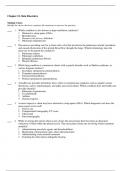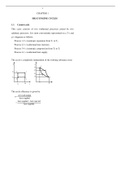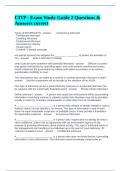Chapter 21, Skin Disorders
Multiple Choice
Identify the choice that best completes the statement or answers the question.
1. Which condition is also known as hypoventilation syndrome?
1. Obstructive sleep apnea (OSA)
2. Bronchiectasis
3. Pneumocystis jiroveci infection
4. Pulmonary hypertension
2. The nurse is providing care for a client with a clot that traveled to the pulmonary arterial circulation
and caused obstruction of the arterial blood flow through the lungs. Which terminology does the
nurse use to document the condition?
1. Pulmonary edema
2. Pulmonary embolism
3. Idiopathic pulmonary fibrosis
4. Pleural effusion
3. Which lung condition is common in clients with a genetic disorder such as Marfan syndrome, as
well as frequent smokers?
1. Secondary spontaneous pneumothorax
2. Traumatic pneumothorax
3. Tension pneumothorax
4. Primary spontaneous pneumothorax
4. A health-care provider determines that a client is experiencing symptoms such as jugular venous
distension, ascites, hepatomegaly, and ankle and sacral edema. Which condition does the health-care
provider identify?
1. Pulmonary hypertension
2. Cor pulmonale
3. Asthma
4. Chronic hypoxia
5. A nurse suspects a client may have obstructive sleep apnea (OSA). Which diagnostic tool does the
nurse expect to be used?
1. Chest x-ray
2. Computerized tomography (CT scan)
3. Ultrasound
4. Polysomnography
6. While reviewing the reports about a new client, the nurse learns there has been an abnormal
collection of fluid within the pleural cavity. The nurse plans client care involving which treatment
modality?
1. Administering mucolytic agents and bronchodilators
2. Monitoring a thoracotomy and a chest tube placement
3. Administering corticosteroid treatment
4. Teaching the client about orthopedic bracing
, 7. The nurse finds that the client is exhibiting wheezing, prolonged exhalations, and rhonchi. The client
uses accessory muscles during breathing. As a treatment, the health-care provider prescribes
bronchodilators and corticosteroids in the form of inhalers. Which disorder does the nurse identify
related to the symptoms and treatment of the client?
1. The client has idiopathic pulmonary fibrosis.
2. The client exhibits signs of bronchiectasis.
3. The client has manifestations of asthma.
4. The client is experiencing pleural effusion.
8. The nurse is assessing a young adult client who has a history of smoking and Marfan syndrome.
Previous medical reports do not suggest evidence of underlying lung disease. For which condition is
the client at risk?
1. Traumatic pneumothorax
2. Tension pneumothorax
3. Iatrogenic pneumothorax
4. Primary spontaneous pneumothorax
9. A victim of a motor vehicle accident comes to a medical facility with a rib fracture that has
punctured the pleural membrane. The open wound allows the pleural cavity to pull air into the
opening of the wound, thus building a pleural space. Which treatment can a nurse expect from the
primary health-care provider?
1. A large-bore needle to be inserted in the affected side
2. The process of pleurodesis to be performed on the client
3. A chest tube with suctioNnUtoRbSeIaN
ppGliTedB.
onCtO
heMaffected side
4. Surgical intervention of the affected side
10. A middle-age client presents with a cough producing large amounts of mucus. The client tells the
nurse, “I get this and keep it all winter. My wife says I cough until I turn blue.” With a suspicion of
chronic bronchitis, which question does the nurse ask first?
1. “Do you feel short of breath after a coughing spell?”
2. “So, how many years have you had this problem?”
3. “Does anyone else in your family have this problem?”
4. “Do you get your annual influenza vaccine?”
11. When viewing the recent chest x-rays of a client, the nurse finds nodules and honeycomb lung
patterns. The health-care provider points out the client’s previous chest x-ray report identifying
diffused “ground glass” markings in the lower lung fields. Which condition does the nurse conclude
from this information?
1. Idiopathic pulmonary fibrosis
2. Thoracic cage deformity
3. Pleural effusion
4. Pulmonary embolism
12. The nurse is assessing a client diagnosed with secondary pulmonary hypertension. The increase in
the pulmonary artery pressure has led to the client’s elevated pulmonary venous pressure. Which
existing condition may be identified as the cause of the client’s condition?
1. Spontaneous pneumothorax
2. Anthracosis
, 3. Collagen vascular disease
4. Bronchiectasis
13. The nurse is assessing a client who is obese with a short, thick neck circumference. Which form of
restrictive pulmonary disorder does the nurse suspect in the client?
1. Pickwickian syndrome
2. Allergic bronchopulmonary aspergillosis
3. Cor pulmonale
4. Marfan syndrome
14. A client is being examined by the health-care provider because of a report of “always feeling like I
am holding air in my lungs.” Which specific measurement from a pulmonary function test does the
nurse expect to be most informative?
1. Tidal volume (TV)
2. Functional residual capacity (FRC)
3. Forced vital capacity (FVC)
4. Total lung capacity (TLC)
15. The nurse is assessing a client who has been a butcher for an extensive period, making the client
subject to a prolonged and intense exposure to inhaled organic dust in the form of animal protein.
Which disorder, according to the nurse, is a probable cause of the client’s respiratory problem?
1. Idiopathic pulmonary fibrosis
2. Hypersensitivity pneumonitis
3. Anthracosis
4. Respiratory distress synNdrUoR
mSe INGTB.COM
16. A client diagnosed with pulmonary obstructive disease is progressively exhibiting symptoms that the
condition is worsening. The client’s condition is specifically identified as emphysema. When the
client asks about surgery, which procedure is most likely to be considered for the client?
1. Lung volume reduction surgery (LVRS)
2. Bronchoscopic lung volume reduction (BLVR)
3. A tracheotomy for mechanical ventilation
4. Bilateral lung transplant
17. The nurse is advising a client about adult respiratory distress syndrome (ARDS). Which statement
validates the nurse’s understanding of the disorder?
1. “ARDS develops within 48 to 72 hours of the inciting event.”
2. “ARDS leads to acute pancreatitis or aspiration.”
3. “ARDS causes multiple organ failure and critical illness.”
4. “ARDS is a genetic disorder causing abnormal pulmonary vessel formation.”
18. The nurse is teaching a client about obstructive sleep apnea (OSA). Which treatment, according to
the nurse, is most appropriate to keep the airways from closing?
1. Continuous positive airway pressure (CPAP)
2. Polysomnography
3. Central nervous system stimulants
4. Leukotriene antagonists
Multiple Choice
Identify the choice that best completes the statement or answers the question.
1. Which condition is also known as hypoventilation syndrome?
1. Obstructive sleep apnea (OSA)
2. Bronchiectasis
3. Pneumocystis jiroveci infection
4. Pulmonary hypertension
2. The nurse is providing care for a client with a clot that traveled to the pulmonary arterial circulation
and caused obstruction of the arterial blood flow through the lungs. Which terminology does the
nurse use to document the condition?
1. Pulmonary edema
2. Pulmonary embolism
3. Idiopathic pulmonary fibrosis
4. Pleural effusion
3. Which lung condition is common in clients with a genetic disorder such as Marfan syndrome, as
well as frequent smokers?
1. Secondary spontaneous pneumothorax
2. Traumatic pneumothorax
3. Tension pneumothorax
4. Primary spontaneous pneumothorax
4. A health-care provider determines that a client is experiencing symptoms such as jugular venous
distension, ascites, hepatomegaly, and ankle and sacral edema. Which condition does the health-care
provider identify?
1. Pulmonary hypertension
2. Cor pulmonale
3. Asthma
4. Chronic hypoxia
5. A nurse suspects a client may have obstructive sleep apnea (OSA). Which diagnostic tool does the
nurse expect to be used?
1. Chest x-ray
2. Computerized tomography (CT scan)
3. Ultrasound
4. Polysomnography
6. While reviewing the reports about a new client, the nurse learns there has been an abnormal
collection of fluid within the pleural cavity. The nurse plans client care involving which treatment
modality?
1. Administering mucolytic agents and bronchodilators
2. Monitoring a thoracotomy and a chest tube placement
3. Administering corticosteroid treatment
4. Teaching the client about orthopedic bracing
, 7. The nurse finds that the client is exhibiting wheezing, prolonged exhalations, and rhonchi. The client
uses accessory muscles during breathing. As a treatment, the health-care provider prescribes
bronchodilators and corticosteroids in the form of inhalers. Which disorder does the nurse identify
related to the symptoms and treatment of the client?
1. The client has idiopathic pulmonary fibrosis.
2. The client exhibits signs of bronchiectasis.
3. The client has manifestations of asthma.
4. The client is experiencing pleural effusion.
8. The nurse is assessing a young adult client who has a history of smoking and Marfan syndrome.
Previous medical reports do not suggest evidence of underlying lung disease. For which condition is
the client at risk?
1. Traumatic pneumothorax
2. Tension pneumothorax
3. Iatrogenic pneumothorax
4. Primary spontaneous pneumothorax
9. A victim of a motor vehicle accident comes to a medical facility with a rib fracture that has
punctured the pleural membrane. The open wound allows the pleural cavity to pull air into the
opening of the wound, thus building a pleural space. Which treatment can a nurse expect from the
primary health-care provider?
1. A large-bore needle to be inserted in the affected side
2. The process of pleurodesis to be performed on the client
3. A chest tube with suctioNnUtoRbSeIaN
ppGliTedB.
onCtO
heMaffected side
4. Surgical intervention of the affected side
10. A middle-age client presents with a cough producing large amounts of mucus. The client tells the
nurse, “I get this and keep it all winter. My wife says I cough until I turn blue.” With a suspicion of
chronic bronchitis, which question does the nurse ask first?
1. “Do you feel short of breath after a coughing spell?”
2. “So, how many years have you had this problem?”
3. “Does anyone else in your family have this problem?”
4. “Do you get your annual influenza vaccine?”
11. When viewing the recent chest x-rays of a client, the nurse finds nodules and honeycomb lung
patterns. The health-care provider points out the client’s previous chest x-ray report identifying
diffused “ground glass” markings in the lower lung fields. Which condition does the nurse conclude
from this information?
1. Idiopathic pulmonary fibrosis
2. Thoracic cage deformity
3. Pleural effusion
4. Pulmonary embolism
12. The nurse is assessing a client diagnosed with secondary pulmonary hypertension. The increase in
the pulmonary artery pressure has led to the client’s elevated pulmonary venous pressure. Which
existing condition may be identified as the cause of the client’s condition?
1. Spontaneous pneumothorax
2. Anthracosis
, 3. Collagen vascular disease
4. Bronchiectasis
13. The nurse is assessing a client who is obese with a short, thick neck circumference. Which form of
restrictive pulmonary disorder does the nurse suspect in the client?
1. Pickwickian syndrome
2. Allergic bronchopulmonary aspergillosis
3. Cor pulmonale
4. Marfan syndrome
14. A client is being examined by the health-care provider because of a report of “always feeling like I
am holding air in my lungs.” Which specific measurement from a pulmonary function test does the
nurse expect to be most informative?
1. Tidal volume (TV)
2. Functional residual capacity (FRC)
3. Forced vital capacity (FVC)
4. Total lung capacity (TLC)
15. The nurse is assessing a client who has been a butcher for an extensive period, making the client
subject to a prolonged and intense exposure to inhaled organic dust in the form of animal protein.
Which disorder, according to the nurse, is a probable cause of the client’s respiratory problem?
1. Idiopathic pulmonary fibrosis
2. Hypersensitivity pneumonitis
3. Anthracosis
4. Respiratory distress synNdrUoR
mSe INGTB.COM
16. A client diagnosed with pulmonary obstructive disease is progressively exhibiting symptoms that the
condition is worsening. The client’s condition is specifically identified as emphysema. When the
client asks about surgery, which procedure is most likely to be considered for the client?
1. Lung volume reduction surgery (LVRS)
2. Bronchoscopic lung volume reduction (BLVR)
3. A tracheotomy for mechanical ventilation
4. Bilateral lung transplant
17. The nurse is advising a client about adult respiratory distress syndrome (ARDS). Which statement
validates the nurse’s understanding of the disorder?
1. “ARDS develops within 48 to 72 hours of the inciting event.”
2. “ARDS leads to acute pancreatitis or aspiration.”
3. “ARDS causes multiple organ failure and critical illness.”
4. “ARDS is a genetic disorder causing abnormal pulmonary vessel formation.”
18. The nurse is teaching a client about obstructive sleep apnea (OSA). Which treatment, according to
the nurse, is most appropriate to keep the airways from closing?
1. Continuous positive airway pressure (CPAP)
2. Polysomnography
3. Central nervous system stimulants
4. Leukotriene antagonists






